MERCEDES-BENZ GLE COUPE 2015 Owners Manual
Manufacturer: MERCEDES-BENZ, Model Year: 2015, Model line: GLE COUPE, Model: MERCEDES-BENZ GLE COUPE 2015Pages: 393, PDF Size: 12.71 MB
Page 381 of 393
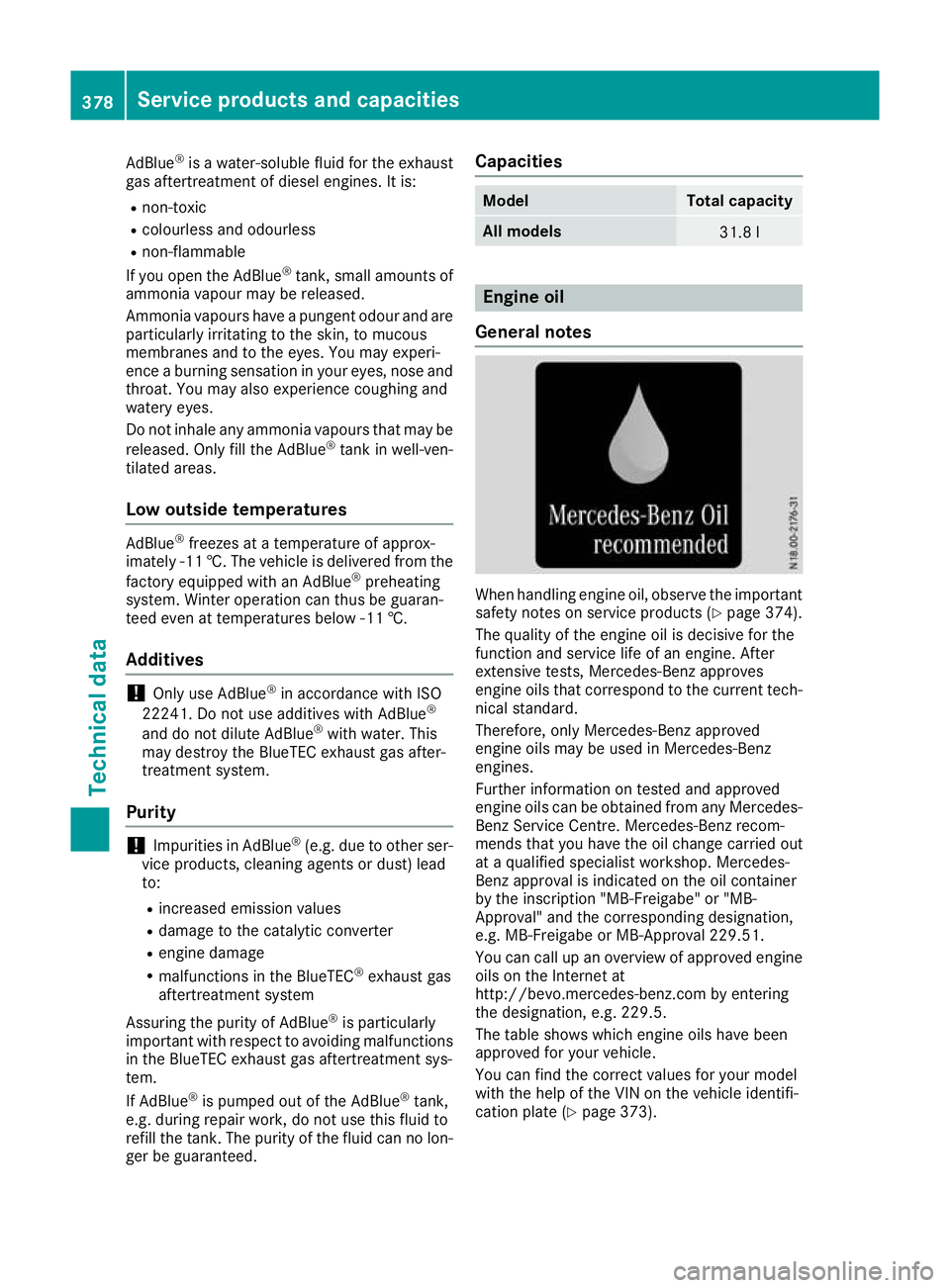
AdBlue
®
is a water-soluble fluid for the exhaust
gas aftertreatment of diesel engines. It is:
R non-toxic
R colourless and odourless
R non-flammable
If you open the AdBlue ®
tank, small amounts of
ammonia vapour may be released.
Ammonia vapours have a pungent odour and are
particularly irritating to the skin, to mucous
membranes and to the eyes. You may experi-
ence a burning sensation in your eyes, nose and throat. You may also experience coughing and
watery eyes.
Do not inhale any ammonia vapours that may be
released. Only fill the AdBlue ®
tank in well-ven-
tilated areas.
Low outside temperatures AdBlue
®
freezes at a temperature of approx-
imately -11 †. The vehicle is delivered from the
factory equipped with an AdBlue ®
preheating
system. Winter operation can thus be guaran-
teed even at temperatures below -11 †.
Additives !
Only use AdBlue ®
in accordance with ISO
22241. Do not use additives with AdBlue ®
and do not dilute AdBlue ®
with water. This
may destroy the BlueTEC exhaust gas after-
treatment system.
Purity !
Impurities in AdBlue ®
(e.g. due to other ser-
vice products, cleaning agents or dust) lead
to:
R increased emission values
R damage to the catalytic converter
R engine damage
R malfunctions in the BlueTEC ®
exhaust gas
aftertreatment system
Assuring the purity of AdBlue ®
is particularly
important with respect to avoiding malfunctions
in the BlueTEC exhaust gas aftertreatment sys-
tem.
If AdBlue ®
is pumped out of the AdBlue ®
tank,
e.g. during repair work, do not use this fluid to
refill the tank. The purity of the fluid can no lon-
ger be guaranteed. Capacities Model Total capacity
All models
31.8 l
Engine oil
General notes When handling engine oil, observe the important
safety notes on service products (Y page 374).
The quality of the engine oil is decisive for the
function and service life of an engine. After
extensive tests, Mercedes-Benz approves
engine oils that correspond to the current tech-
nical standard.
Therefore, only Mercedes-Benz approved
engine oils may be used in Mercedes-Benz
engines.
Further information on tested and approved
engine oils can be obtained from any Mercedes-
Benz Service Centre. Mercedes-Benz recom-
mends that you have the oil change carried out
at a qualified specialist workshop. Mercedes-
Benz approval is indicated on the oil container
by the inscription "MB-Freigabe" or "MB-
Approval" and the corresponding designation,
e.g. MB-Freigabe or MB-Approval 229.51.
You can call up an overview of approved engine oils on the Internet at
http://bevo.mercedes-benz.com by entering
the designation, e.g. 229.5.
The table shows which engine oils have been
approved for your vehicle.
You can find the correct values for your model
with the help of the VIN on the vehicle identifi-
cation plate (Y page 373).378
Service products and capacitiesTechnical data
Page 382 of 393
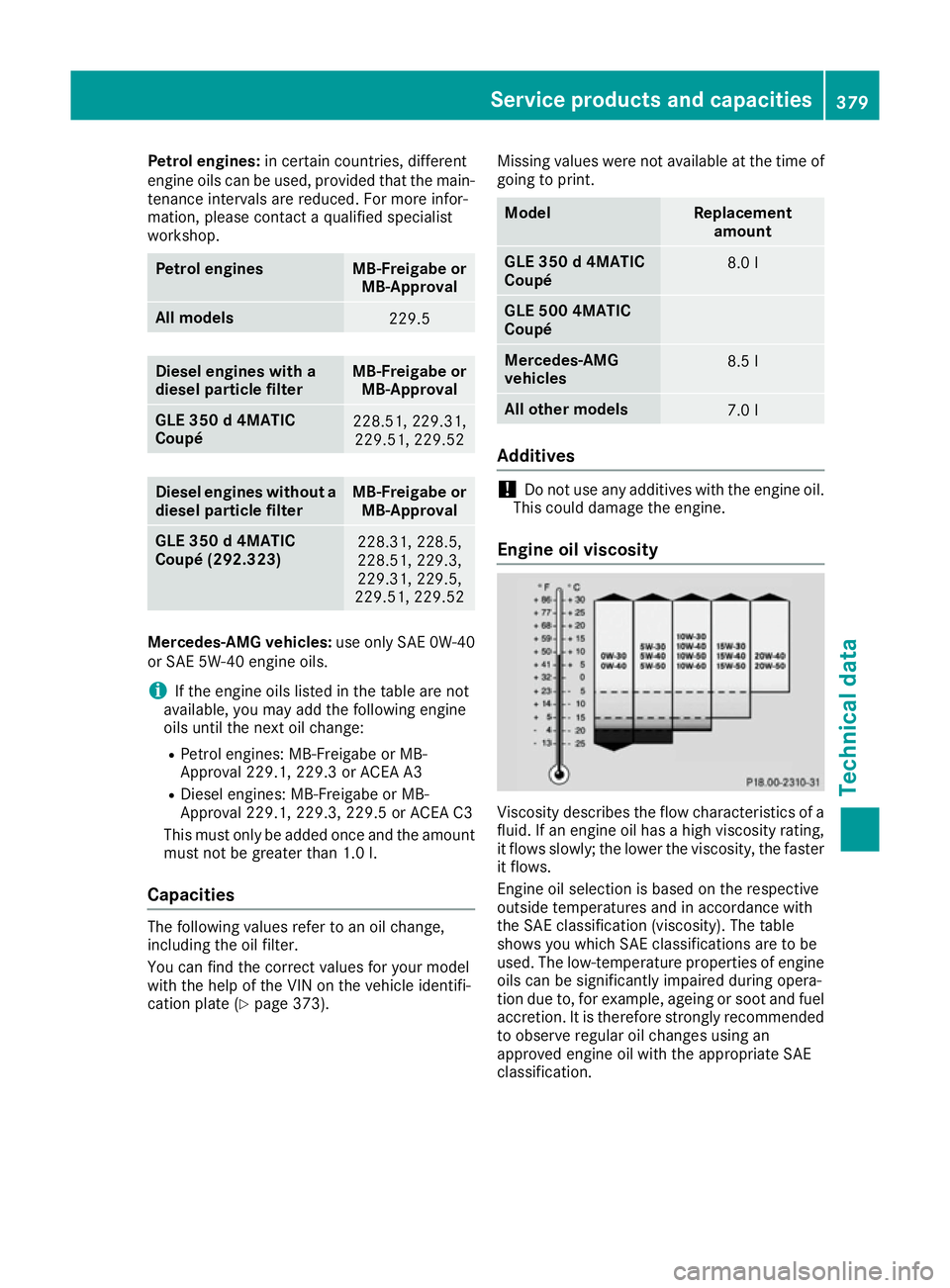
Petrol engines:
in certain countries, different
engine oils can be used, provided that the main-
tenance intervals are reduced. For more infor-
mation, please contact a qualified specialist
workshop. Petrol engines MB-Freigabe or
MB-Approval All models
229.5
Diesel engines with a
diesel particle filter MB-Freigabe or
MB-Approval GLE 350 d 4MATIC
Coupé
228.51, 229.31,
229.51, 229.52 Diesel engines without a
diesel particle filter MB-Freigabe or
MB-Approval GLE 350 d 4MATIC
Coupé (292.323)
228.31, 228.5,
228.51, 229.3,
229.31, 229.5,
229.51, 229.52 Mercedes‑AMG vehicles:
use only SAE 0W-40
or SAE 5W-40 engine oils.
i If the engine oils listed in the table are not
available, you may add the following engine
oils until the next oil change:
R Petrol engines: MB-Freigabe or MB-
Approval 229.1, 229.3 or ACEA A3
R Diesel engines: MB-Freigabe or MB-
Approval 229.1, 229.3, 229.5 or ACEA C3
This must only be added once and the amount must not be greater than 1.0 l.
Capacities The following values refer to an oil change,
including the oil filter.
You can find the correct values for your model
with the help of the VIN on the vehicle identifi-
cation plate (Y
page 373). Missing values were not available at the time of
going to print. Model Replacement
amount GLE 350 d 4MATIC
Coupé
8.0 l
GLE 500 4MATIC
Coupé
Mercedes-AMG
vehicles
8.5 l
All other models
7.0 l
Additives
!
Do not use any additives with the engine oil.
This could damage the engine.
Engine oil viscosity Viscosity describes the flow characteristics of a
fluid. If an engine oil has a high viscosity rating, it flows slowly; the lower the viscosity, the faster
it flows.
Engine oil selection is based on the respective
outside temperatures and in accordance with
the SAE classification (viscosity). The table
shows you which SAE classifications are to be
used. The low-temperature properties of engine
oils can be significantly impaired during opera-
tion due to, for example, ageing or soot and fuel
accretion. It is therefore strongly recommended to observe regular oil changes using an
approved engine oil with the appropriate SAE
classification. Service products and capacities
379Technical data Z
Page 383 of 393
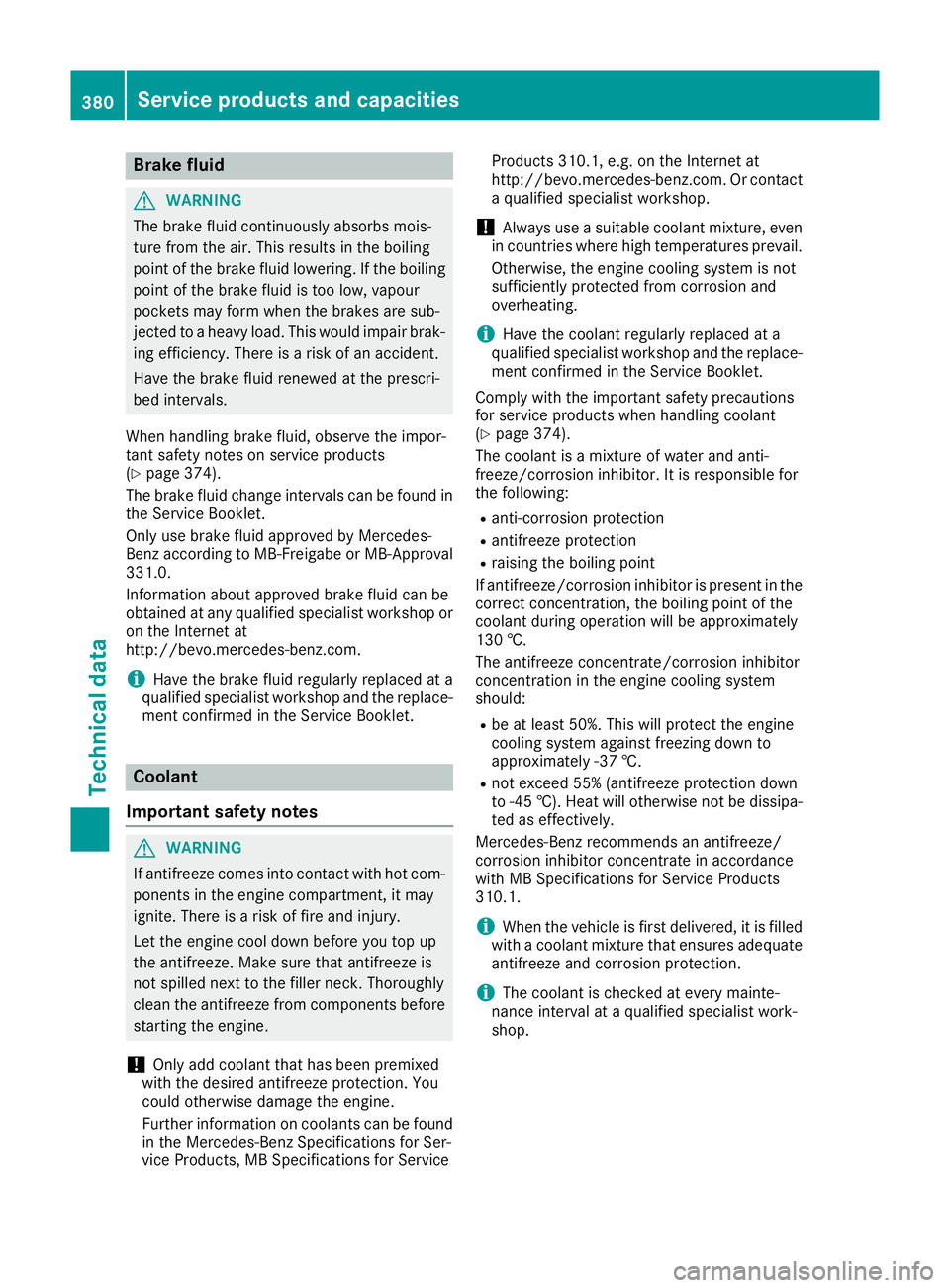
Brake fluid
G
WARNING
The brake fluid continuously absorbs mois-
ture from the air. This results in the boiling
point of the brake fluid lowering. If the boiling
point of the brake fluid is too low, vapour
pockets may form when the brakes are sub-
jected to a heavy load. This would impair brak- ing efficiency. There is a risk of an accident.
Have the brake fluid renewed at the prescri-
bed intervals.
When handling brake fluid, observe the impor-
tant safety notes on service products
(Y page 374).
The brake fluid change intervals can be found in the Service Booklet.
Only use brake fluid approved by Mercedes-
Benz according to MB-Freigabe or MB-Approval
331.0.
Information about approved brake fluid can be
obtained at any qualified specialist workshop or on the Internet at
http://bevo.mercedes-benz.com.
i Have the brake fluid regularly replaced at a
qualified specialist workshop and the replace- ment confirmed in the Service Booklet. Coolant
Important safety notes G
WARNING
If antifreeze comes into contact with hot com- ponents in the engine compartment, it may
ignite. There is a risk of fire and injury.
Let the engine cool down before you top up
the antifreeze. Make sure that antifreeze is
not spilled next to the filler neck. Thoroughly
clean the antifreeze from components before
starting the engine.
! Only add coolant that has been premixed
with the desired antifreeze protection. You
could otherwise damage the engine.
Further information on coolants can be found in the Mercedes-Benz Specifications for Ser-
vice Products, MB Specifications for Service Products 310.1, e.g. on the Internet at
http://bevo.mercedes-benz.com. Or contact
a qualified specialist workshop.
! Always use a suitable coolant mixture, even
in countries where high temperatures prevail.
Otherwise, the engine cooling system is not
sufficiently protected from corrosion and
overheating.
i Have the coolant regularly replaced at a
qualified specialist workshop and the replace-
ment confirmed in the Service Booklet.
Comply with the important safety precautions
for service products when handling coolant
(Y page 374).
The coolant is a mixture of water and anti-
freeze/corrosion inhibitor. It is responsible for
the following:
R anti-corrosion protection
R antifreeze protection
R raising the boiling point
If antifreeze/corrosion inhibitor is present in the
correct concentration, the boiling point of the
coolant during operation will be approximately
130 †.
The antifreeze concentrate/corrosion inhibitor
concentration in the engine cooling system
should:
R be at least 50%. This will protect the engine
cooling system against freezing down to
approximately -37 †.
R not exceed 55% (antifreeze protection down
to -45 †). Heat will otherwise not be dissipa-
ted as effectively.
Mercedes-Benz recommends an antifreeze/
corrosion inhibitor concentrate in accordance
with MB Specifications for Service Products
310.1.
i When the vehicle is first delivered, it is filled
with a coolant mixture that ensures adequate
antifreeze and corrosion protection.
i The coolant is checked at every mainte-
nance interval at a qualified specialist work-
shop. 380
Service products and capacitiesTechnical data
Page 384 of 393

Windscreen washer system
Important safety notes G
WARNING
If windscreen washer concentrate comes into contact with hot components of the engine or
the exhaust system, it can ignite. There is a
risk of fire and injury.
Make sure the windscreen washer concen-
trate does not come into contact with the filler neck.
! Only use washer fluid that is suitable for
plastic lamp lenses, e.g. MB SummerFit or MB
WinterFit. Unsuitable washer fluid could dam-
age the plastic lenses of the headlamps.
! Only the washer fluids SummerFit and Win-
terFit can be mixed. Otherwise, the spraying
nozzles could become blocked.
Do not use distilled or de-ionised water as the
level sensor may be triggered erroneously.
When handling washer fluid, observe the impor- tant safety notes on service products
(Y page 374).
At temperatures above freezing:
X Fill the washer fluid reservoir with a mixture of
water and washer fluid, e.g. MB SummerFit.
Mix 1 part MB SummerFit to 100 parts water.
At temperatures below freezing:
X Fill the washer fluid reservoir with a mixture of
water and washer fluid, e.g. MB WinterFit.
For the correct mixing ratio refer to the infor- mation on the antifreeze reservoir.
i Add washer fluid concentrate, e.g. MB Sum-
merFit or MB WinterFit, to the washer fluid all
year round. Vehicle data
General notes
Please note that for the specified vehicle data: R the heights specified may vary as a result of:
- tyres
- load
- condition of the suspension
- optional equipment
R optional equipment reduces the maximum
payload
R vehicle-specific weight information can be
found on the vehicle identification plate
(Y page 373).
R only for certain countries: you can find vehi-
cle-specific vehicle data in the COC docu-
ments (CERTIFICATE OF CONFORMITY).
These documents are delivered with your
vehicle Dimensions and weights
You can find the correct values for your model
with the help of the VIN on the vehicle identifi-
cation plate (Y page 373).
Missing values were not available at the time of
going to print. Model
: :
Opening height ;
;
Maximum
headroom GLE 500
4MATIC Coupé
Mercedes‑Ben
z GLE 450 AMG
4MATIC Coupé 1972 mmVehicle data
381Technical data Z
Page 385 of 393
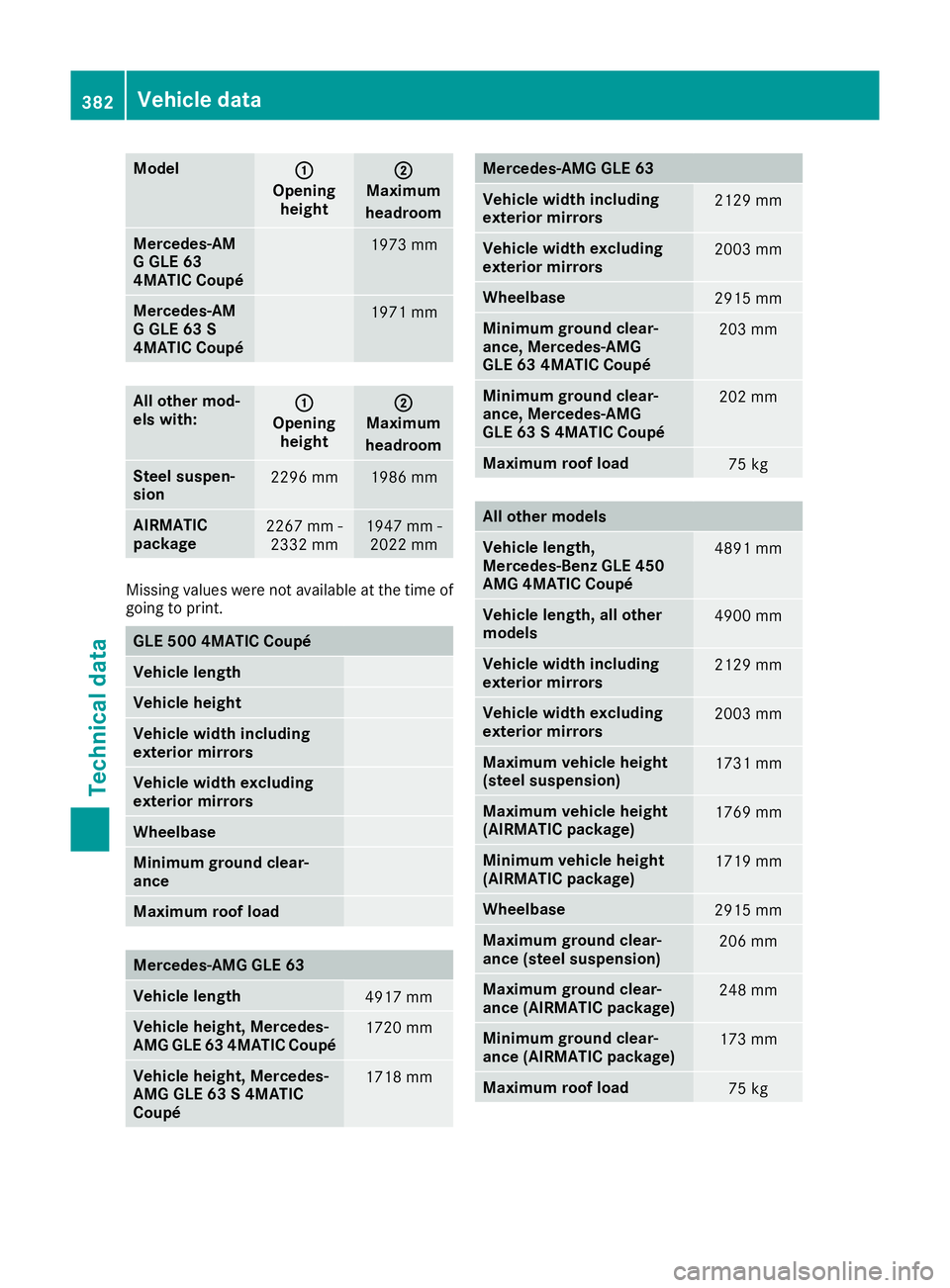
Model
:
:
Opening height ;
;
Maximum
headroom Mercedes‑AM
G GLE 63
4MATIC Coupé
1973 mm
Mercedes‑AM
G GLE 63 S
4MATIC Coupé
1971 mm
All other mod-
els with:
: :
Opening height ;
;
Maximum
headroom Steel suspen-
sion
2296 mm 1986 mm
AIRMATIC
package
2267 mm -
2332 mm 1947 mm -
2022 mm Missing values were not available at the time of
going to print. GLE 500 4MATIC Coupé
Vehicle length
Vehicle height
Vehicle width including
exterior mirrors
Vehicle width excluding
exterior mirrors Wheelbase
Minimum ground clear-
ance
Maximum roof load
Mercedes‑AMG GLE 63
Vehicle length
4917 mm
Vehicle height, Mercedes-
AMG GLE 63 4MATIC Coupé
1720 mm
Vehicle height, Mercedes-
AMG GLE 63 S 4MATIC
Coupé
1718 mm Mercedes‑AMG GLE 63
Vehicle width including
exterior mirrors
2129 mm
Vehicle width excluding
exterior mirrors
2003 mm
Wheelbase
2915 mm
Minimum ground clear-
ance, Mercedes-AMG
GLE 63 4MATIC Coupé
203 mm
Minimum ground clear-
ance, Mercedes-AMG
GLE 63 S 4MATIC Coupé
202 mm
Maximum roof load
75 kg
All other models
Vehicle length,
Mercedes‑Benz GLE 450
AMG 4MATIC Coupé 4891 mm
Vehicle length, all other
models
4900 mm
Vehicle width including
exterior mirrors
2129 mm
Vehicle width excluding
exterior mirrors
2003 mm
Maximum vehicle height
(steel suspension)
1731 mm
Maximum vehicle height
(AIRMATIC package)
1769 mm
Minimum vehicle height
(AIRMATIC package)
1719 mm
Wheelbase
2915 mm
Maximum ground clear-
ance (steel suspension)
206 mm
Maximum ground clear-
ance (AIRMATIC package)
248 mm
Minimum ground clear-
ance (AIRMATIC package)
173 mm
Maximum roof load
75 kg382
Vehicle dataTechnical data
Page 386 of 393
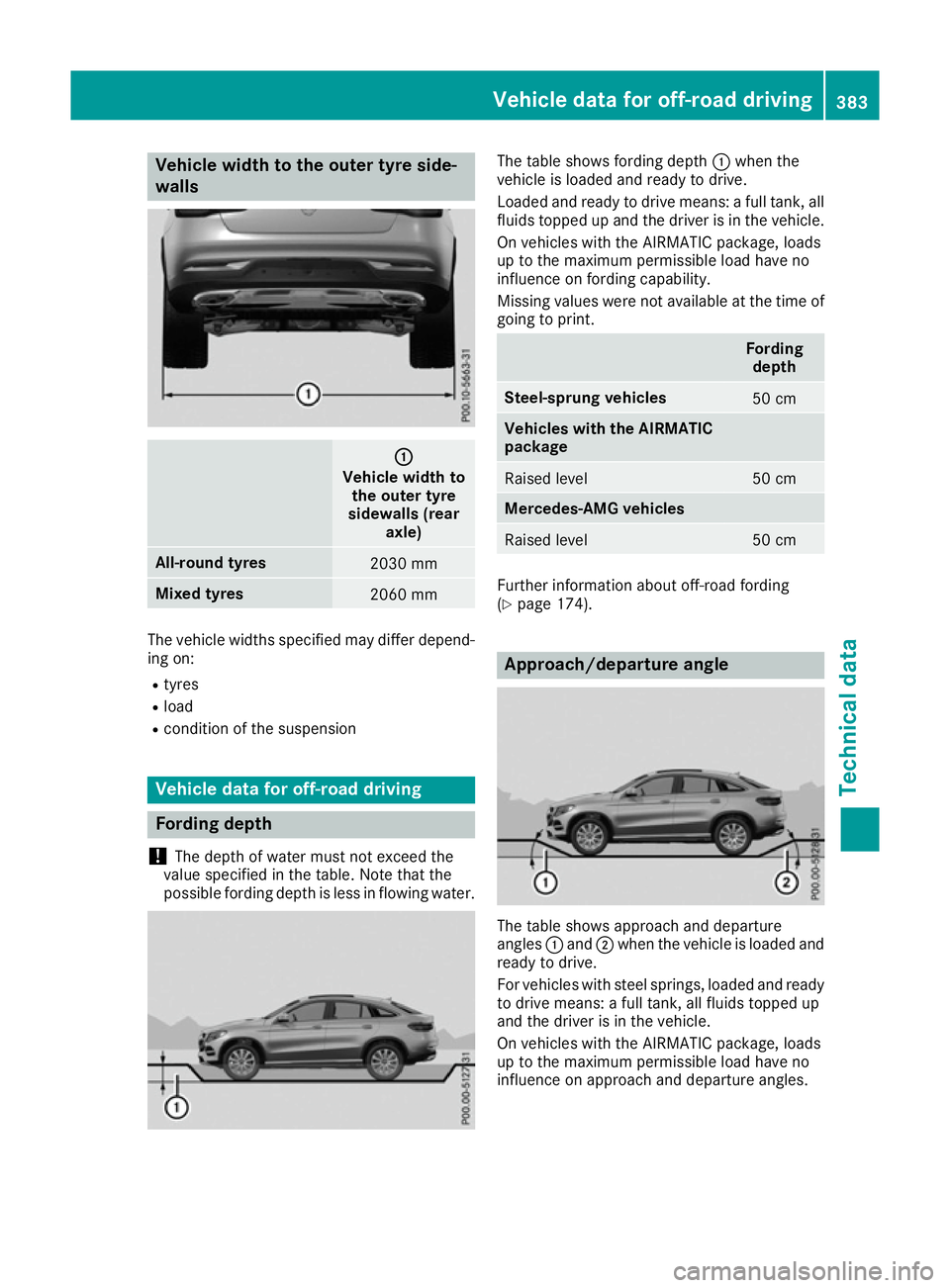
Vehicle width to the outer tyre side-
walls :
:
Vehicle width to the outer tyre
sidewalls (rear axle) All-round tyres
2030 mm
Mixed tyres
2060 mm
The vehicle widths specified may differ depend-
ing on:
R tyres
R load
R condition of the suspension Vehicle data for off-road driving
Fording depth
! The depth of water must not exceed the
value specified in the table. Note that the
possible fording depth is less in flowing water. The table shows fording depth
:when the
vehicle is loaded and ready to drive.
Loaded and ready to drive means: a full tank, all fluids topped up and the driver is in the vehicle.
On vehicles with the AIRMATIC package, loads
up to the maximum permissible load have no
influence on fording capability.
Missing values were not available at the time of
going to print. Fording
depth Steel-sprung vehicles
50 cm
Vehicles with the AIRMATIC
package Raised level 50 cm
Mercedes-AMG vehicles
Raised level 50 cm
Further information about off-road fording
(Y
page 174). Approach/departure angle
The table shows approach and departure
angles
:and ;when the vehicle is loaded and
ready to drive.
For vehicles with steel springs, loaded and ready
to drive means: a full tank, all fluids topped up
and the driver is in the vehicle.
On vehicles with the AIRMATIC package, loads
up to the maximum permissible load have no
influence on approach and departure angles. Vehicle data for off-road driving
383Technical data Z
Page 387 of 393
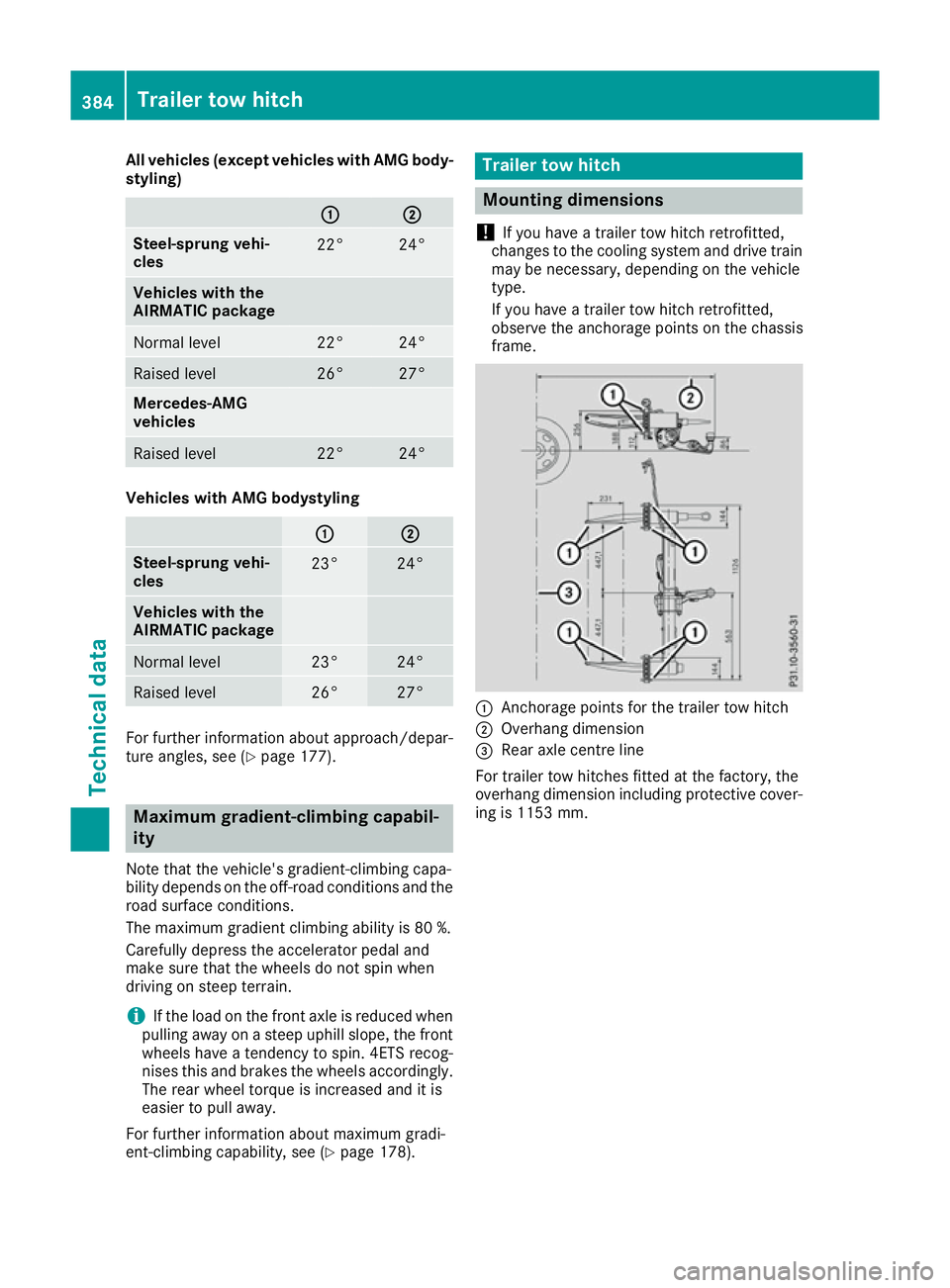
All vehicles (except vehicles with AMG body-
styling) :
: ;
;
Steel-sprung vehi-
cles
22° 24°
Vehicles with the
AIRMATIC package Normal level 22° 24°
Raised level 26° 27°
Mercedes-AMG
vehicles
Raised level 22° 24°
Vehicles with AMG bodystyling
: : ;
;
Steel-sprung vehi-
cles
23° 24°
Vehicles with the
AIRMATIC package
Normal level 23° 24°
Raised level 26° 27°
For further information about approach/depar-
ture angles, see (Y
page 177).Maximum gradient-climbing capabil-
ity
Note that the vehicle's gradient-climbing capa-
bility depends on the off-road conditions and the road surface conditions.
The maximum gradient climbing ability is 80 %.
Carefully depress the accelerator pedal and
make sure that the wheels do not spin when
driving on steep terrain.
i If the load on the front axle is reduced when
pulling away on a steep uphill slope, the front
wheels have a tendency to spin. 4ETS recog-
nises this and brakes the wheels accordingly. The rear wheel torque is increased and it is
easier to pull away.
For further information about maximum gradi-
ent-climbing capability, see (Y page 178). Trailer tow hitch
Mounting dimensions
! If you have a trailer tow hitch retrofitted,
changes to the cooling system and drive train
may be necessary, depending on the vehicle
type.
If you have a trailer tow hitch retrofitted,
observe the anchorage points on the chassis
frame. :
Anchorage points for the trailer tow hitch
; Overhang dimension
= Rear axle centre line
For trailer tow hitches fitted at the factory, the
overhang dimension including protective cover- ing is 1153 mm. 384
Trailer tow hitchTechnical data
Page 388 of 393
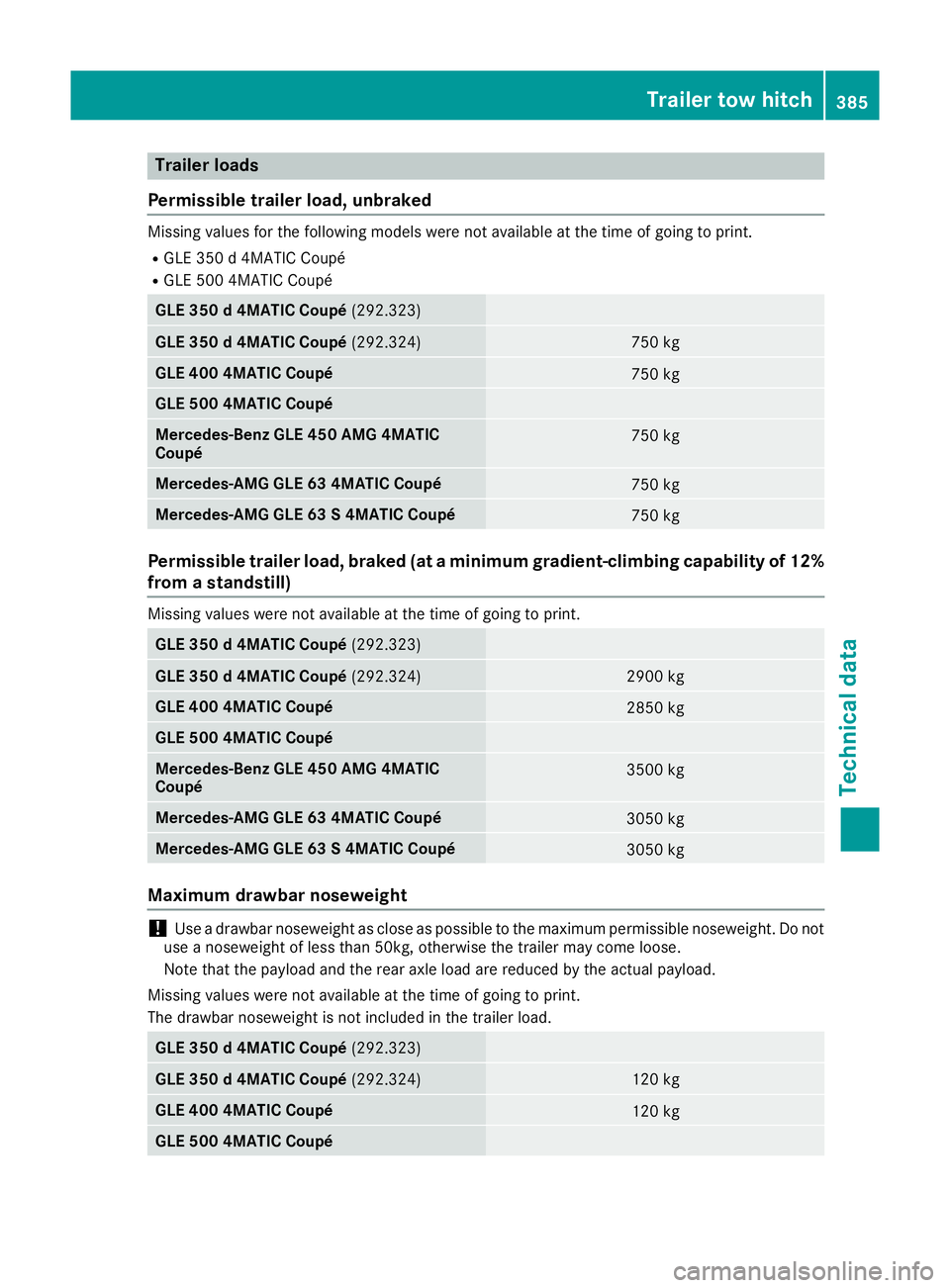
Trailer loads
Permissible trailer load, unbraked Missing values for the following models were not available at the time of going to print.
R GLE 350 d 4MATIC Coupé
R GLE 500 4MATIC Coupé GLE 350 d 4MATIC Coupé
(292.323)GLE 350 d 4MATIC Coupé
(292.324) 750 kg
GLE 400 4MATIC Coupé
750 kg
GLE 500 4MATIC Coupé
Mercedes-Benz GLE 450 AMG 4MATIC
Coupé
750 kg
Mercedes-AMG GLE 63 4MATIC Coupé
750 kg
Mercedes-AMG GLE 63 S 4MATIC Coupé
750 kg
Permissible trailer load, braked (at a minimum gradient-climbing capability of 12%
from a standstill) Missing values were not available at the time of going to print.
GLE 350 d 4MATIC Coupé
(292.323)GLE 350 d 4MATIC Coupé
(292.324) 2900 kg
GLE 400 4MATIC Coupé
2850 kg
GLE 500 4MATIC Coupé
Mercedes-Benz GLE 450 AMG 4MATIC
Coupé
3500 kg
Mercedes-AMG GLE 63 4MATIC Coupé
3050 kg
Mercedes-AMG GLE 63 S 4MATIC Coupé
3050 kg
Maximum drawbar noseweight
!
Use a drawbar noseweight as close as possible to the maximum permissible noseweight. Do not
use a noseweight of less than 50kg, otherwise the trailer may come loose.
Note that the payload and the rear axle load are reduced by the actual payload.
Missing values were not available at the time of going to print.
The drawbar noseweight is not included in the trailer load. GLE 350 d 4MATIC Coupé
(292.323)GLE 350 d 4MATIC Coupé
(292.324) 120 kg
GLE 400 4MATIC Coupé
120 kg
GLE 500 4MATIC Coupé Trailer tow hitch
385Technical data Z
Page 389 of 393
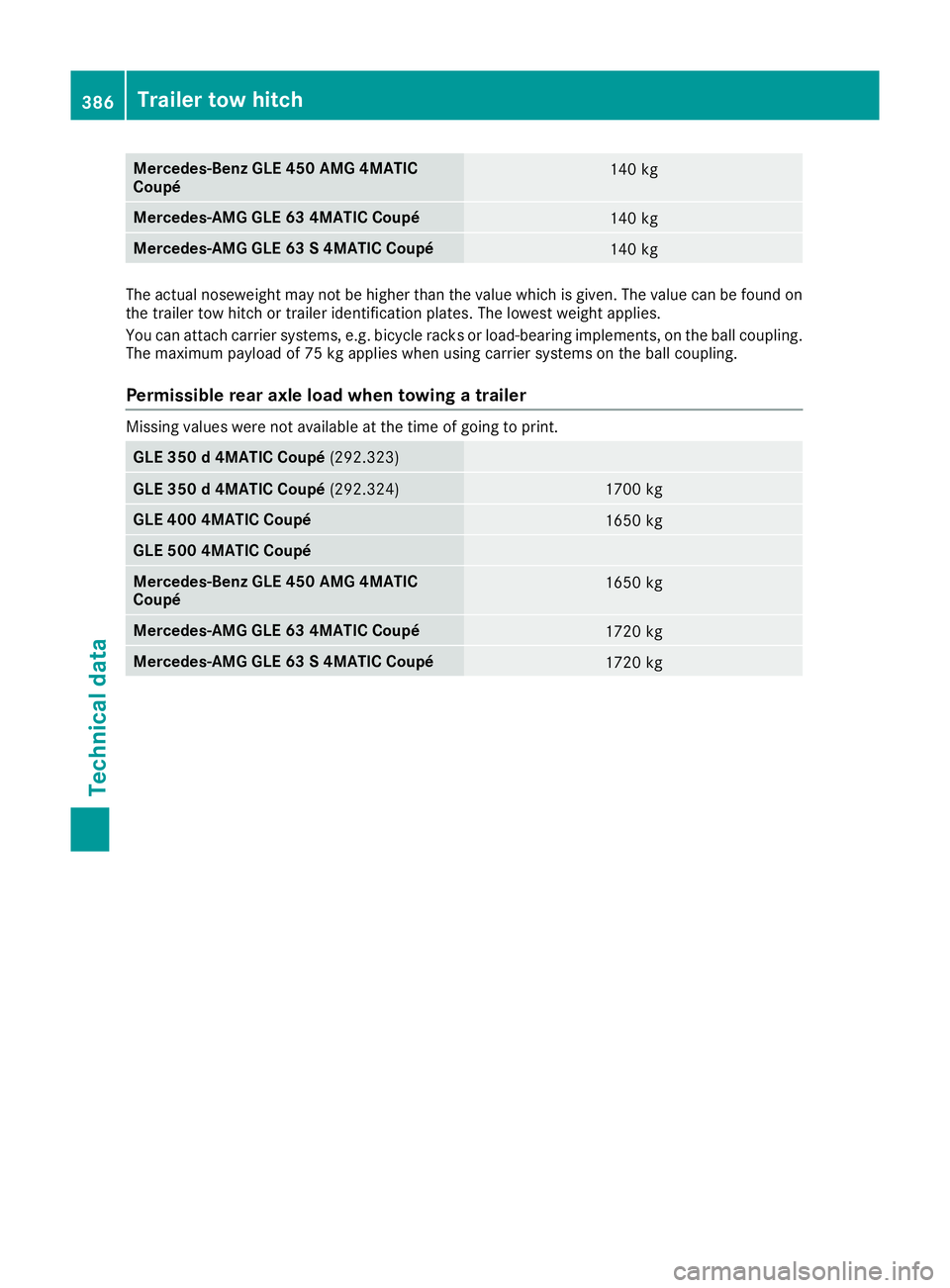
Mercedes-Benz GLE 450 AMG 4MATIC
Coupé
140 kg
Mercedes-AMG GLE 63 4MATIC Coupé
140 kg
Mercedes-AMG GLE 63 S 4MATIC Coupé
140 kg
The actual noseweight may not be higher than the value which is given. The value can be found on
the trailer tow hitch or trailer identification plates. The lowest weight applies.
You can attach carrier systems, e.g. bicycle racks or load-bearing implements, on the ball coupling.
The maximum payload of 75 kg applies when using carrier systems on the ball coupling.
Permissible rear axle load when towing a trailer Missing values were not available at the time of going to print.
GLE 350 d 4MATIC Coupé
(292.323)GLE 350 d 4MATIC Coupé
(292.324) 1700 kg
GLE 400 4MATIC Coupé
1650 kg
GLE 500 4MATIC Coupé
Mercedes-Benz GLE 450 AMG 4MATIC
Coupé
1650 kg
Mercedes-AMG GLE 63 4MATIC Coupé
1720 kg
Mercedes-AMG GLE 63 S 4MATIC Coupé
1720 kg386
Trailer tow hitchTechnical data
Page 390 of 393

387